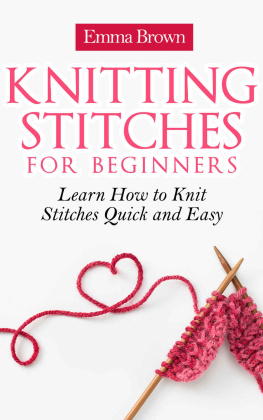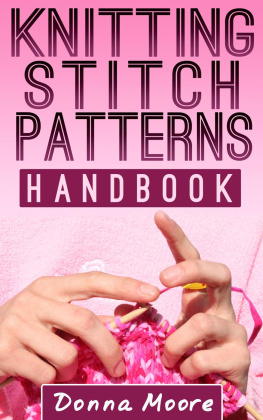

 CONTENTS INTRODUCTIONIN KNITTING, THERE ARE ONLY TWO stitches: knit and purl. From those two stitches come a seemingly infinite number of combinations for creating fabrics that look and feel different. Most of us start out by learning to make a knit stitch, which produces Garter stitch when worked every row. Next, we learn to add purls to the mix to create Stockinette stitch. Last, we combine the two to make ribbing. And whether were knitting flat (back and forth) or in the round, these basic stitches can serve us well for a long, long time.
CONTENTS INTRODUCTIONIN KNITTING, THERE ARE ONLY TWO stitches: knit and purl. From those two stitches come a seemingly infinite number of combinations for creating fabrics that look and feel different. Most of us start out by learning to make a knit stitch, which produces Garter stitch when worked every row. Next, we learn to add purls to the mix to create Stockinette stitch. Last, we combine the two to make ribbing. And whether were knitting flat (back and forth) or in the round, these basic stitches can serve us well for a long, long time.
But at some point, most of us hunger for a little more varietywhat would happen if we played around with our knits and purls? Enter stitch dictionaries. These are bookslike this onefilled to the brim with stitch patterns. I dont know a knitter who doesnt have at least one beloved and well-used volume. As a knitwear designer, I am known for creating garment designs that are knit from the top down, often in the round (for example, a sweater knit from the neckline to the bottom hem in one piece). But during my early years while I was still honing my skills, I discovered that most stitch dictionaries only included instructions for knitting stitch patterns back and forth from the bottom up (for example, as you would knit a sweater in piecesfront, back, and sleevesstarting at the bottom hem). At first, I took it upon myself to translate every stitch pattern I used for my designs in silence, just my needles and me.
And then it occurred to me that I could share the fruits of my labor: my instructions for knitting in different directions. And so I wrote the Up, Down, All-Around Stitch Dictionary, which was published in 2014. My instincts were right. There are, indeed, many other knitters who desire stitch patterns written for knitting in different directions. And they no longer have to go it alone. The response to my first stitch dictionary was so positive that right away I wanted to write another one (and, fortunately, my publisher was all for it).
For this second volume I carefully selected over 150 additional stitch patterns that I love. You can use this volume on its own or in combination with the first. There are only four stitch patterns that are repeated in both volumes, and that is because they are so universal that I think they need to be included in every stitch dictionary: Stockinette stitch, Garter stitch, 1x1 Rib, and 2x2 Rib. As with the first volume, I present the instructions for each stitch pattern in both flat and in-the-round versions. They are all written out line by line for those who prefer written stitch patterns, and most are also charted for those who like following charts. In many cases, the stitch patterns will look the same whether knit from the bottom to the top or from the top down.
There are times, especially in the case of lace patterns, when they wont look exactly the same, so I have created a top-down version that isnt identical but will give you similar results (as is the case with Fern Grotto on ). All of these stitch patterns are perfect for using in top-down or bottom-up garments and accessories. Ive provided a project in each of the chapters to get you started thinking about how to incorporate them. You can follow the instructions exactly as written, but you can also swap in another stitch pattern for the one I used if you want. And if youre in a design-it-on-my-own mood, youll find six formulas at the back of the book starting on : Socks in Two Directions, Hats in Two Directions, and Triangular Shawls in Two Directions. In the Up, Down, All-Around Stitch Dictionary, I included from scratch formulas for a lace stole, mittens, and a top-down cable hat.
If you have both books, mix and match to your hearts content. It makes me so happy to see knitters eyes light up when they realize that all the work of converting these stitch patterns has been done for them and they can get down to the enjoyment of knitting rather than having to pull out graph paper and a pencil and figure it out for themselves. And when I think of how many thousands of other stitch patterns exist, I hunger to tackle those as well! Whatever the future holds (volume 3 perhaps?!), my greatest hope is that youll use these new tools to elevate your skills and to create one-of-a-kind items for yourself and for the people you care about. xx
A
GETTING STARTEDSTITCH DICTIONARIES are like cookbooksyou cant have just one! Not only are they great sources of inspiration, they also offer endless ideas for customizing existing knitting patterns or even designing from scratch. First things first, though: After youve chosen a stitch pattern or two, you need to swatch.
Why Swatch? Swatching gives you a chance to spend some time working with your yarntaking it for a test drive and getting to know it before you get down to the nitty gritty of casting on for the actual project.
Why Swatch? Swatching gives you a chance to spend some time working with your yarntaking it for a test drive and getting to know it before you get down to the nitty gritty of casting on for the actual project.
It will help you to control both the size of the finished project and the feel of your knitted fabric. And it will give you invaluable information about how the knitted fabric will look and wear. At one time or another, most knitters have happily knitted a garment, then tried it on and discovered, to their dismay, that it didnt fit! Knitting a swatch and then checking your gauge will help you to avoid this mishap, and if you check and recheck your gauge and overall measurements as you progress, youll be even more likely to finish with a project that is the exact size you planned for it to be. Another reason to swatch is to find out how your needles and yarn work together. Every yarn, be it wool, synthetic, or cotton, acts differently with different needles. Metal needles with sharp tips may not play well with fuzzy mohair, for example.
Nubby cotton, on the other hand, may not behave with bamboo needles. Looking at your swatch, ask yourself: Does the yarn show off the pattern? Or does the colorway get in the way? Does it pill? Does the yarn bloom (expand) after washing? What about colorfastness? Does the color run out of the yarn when you wash it? Part of the fun of knitting is finding a pattern you love and marrying it with yarn in your stash or from your favorite yarn store, so theres no reason to shy away from this process. Remember, swatching is your friend. Just grab some needles and yarn and see where it takes you. If the drape or gauge is off and theres nothing you can do to make it work, think of it this way: Youll be saving that yarn for a different project. How to Swatch In most knitting patterns, a gauge, or tension, is given for a 4" (10 cm) square. How to Swatch In most knitting patterns, a gauge, or tension, is given for a 4" (10 cm) square.
Your swatch should be at least this size or even bigger, not counting the nonrolling edge, in order to give you the most accurate reading. Using the yarn and needles suggested in the pattern or the yarn of your choice, cast on the number of stitchesor morerequired to achieve a square of at least 4" (10 cm). If youre not sure of the number of stitches you might need, refer to the ball band on your yarn. Also, allow at least two stitches on each side of the swatch to work in a nonrolling edge like Garter stitch. Most knitting patterns will give you a gauge and tell you which stitch pattern to use to measure the gauge. For example, the gauge might be listed as 20 stitches over 4" (10 cm), or 5 stitches per inch (2.5 cm), in Stockinette stitch.
Next page













 CONTENTS INTRODUCTIONIN KNITTING, THERE ARE ONLY TWO stitches: knit and purl. From those two stitches come a seemingly infinite number of combinations for creating fabrics that look and feel different. Most of us start out by learning to make a knit stitch, which produces Garter stitch when worked every row. Next, we learn to add purls to the mix to create Stockinette stitch. Last, we combine the two to make ribbing. And whether were knitting flat (back and forth) or in the round, these basic stitches can serve us well for a long, long time.
CONTENTS INTRODUCTIONIN KNITTING, THERE ARE ONLY TWO stitches: knit and purl. From those two stitches come a seemingly infinite number of combinations for creating fabrics that look and feel different. Most of us start out by learning to make a knit stitch, which produces Garter stitch when worked every row. Next, we learn to add purls to the mix to create Stockinette stitch. Last, we combine the two to make ribbing. And whether were knitting flat (back and forth) or in the round, these basic stitches can serve us well for a long, long time.